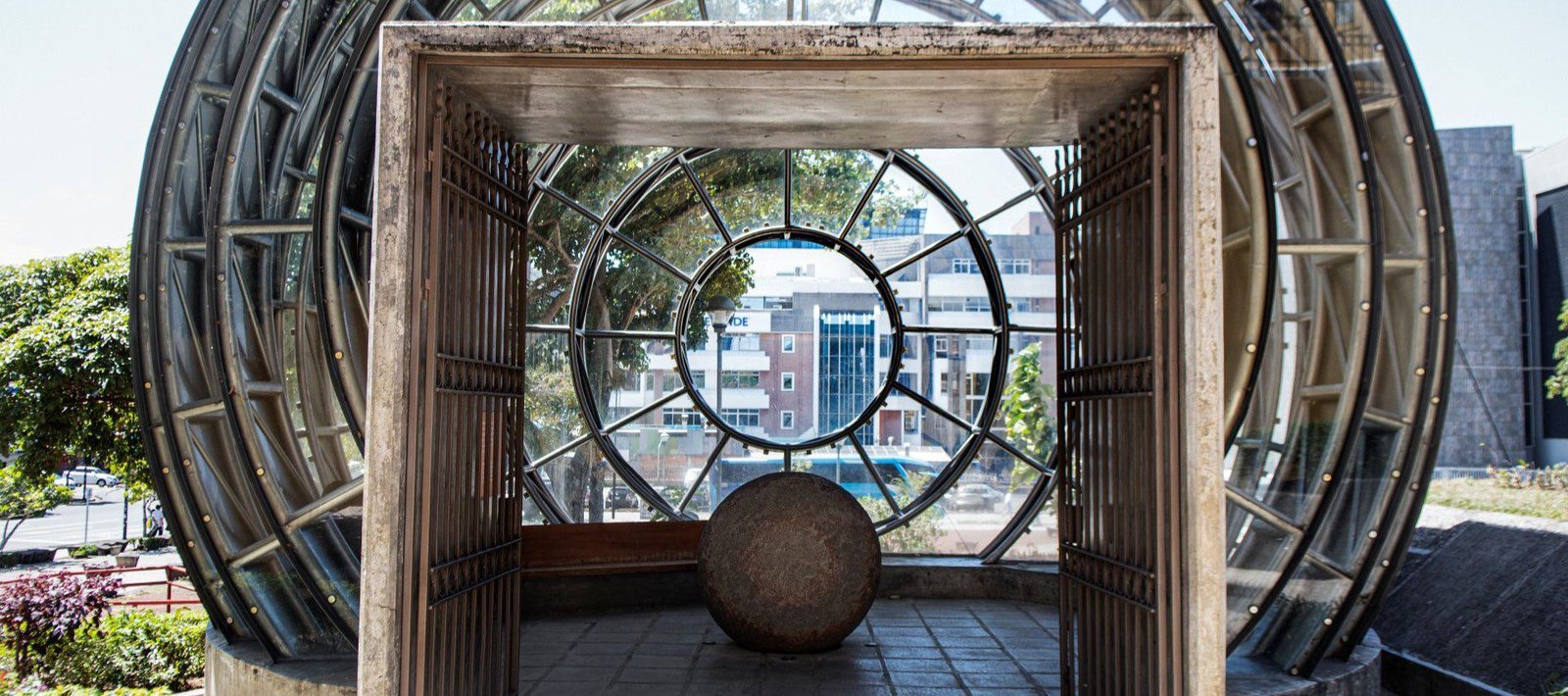
One Hundred Years of “La Cumparsita”
Text and photos: Gloria Algorta
April 19, 1917 marked the first performance of “La Cumparsita,” authored by Uruguayan composer Gerardo Matos Rodríguez, who was just twenty years old at the time. The salons of the La Giralda Café —located in Montevideo on Avenida 18 de Julio, at corner of Andes— were the first to echo with the rhythm of the quintessential tango. The audience that packed the venue demanded encore after encore. “La Cumparsita” would spread around the globe.
This composition has been played around the world in more than 2,700 versions. It has been the subject of legal disputes and its history is as fabled as that of its author.
Nearly one hundred years later, one January morning in 2017, I entered what was once the site of the Café. A man wearing shorts, a T-shirt, and sandals coaxed the chords of the most famous tango of all time from an old piano, masterfully and from memory. He was a Brazilian tourist accompanied by his wife and one of the guides from the “La Cumparsita” Tango Museum, located in the Salvo Palace, which has stood on the site of the legendary La Giralda Café since 1928. Designed by Italian architect Mario Palanti, the Salvo is one of the Uruguayan capital’s iconic buildings. In its time, this was the tallest building in South America. The “La Cumparsita” Tango Museum offers guided tours that include a climb to the cupola, giving visitors a magnificent panoramic view of the city.

Mónica Kaphammel, a young entrepreneur who opened the museum and now serves as its manager, welcomes me affably and guides me through the labyrinthine Salvo Palace as she reveals some of its secrets; she is discreetly neutral on the subject of the ghost that supposedly inhabits the tenth floor. She tells me that she lives in the building and is a member of the Council for the building, which is undergoing a slow, implacable process of restoration.
The Council office holds several ancient treasures: lamps, wall phones, a gramophone with a bronze horn, etc. Mónica is also in charge of renting out the six restored apartments and guests are moving in and out of three of the apartments today, so she is a bit pressed for time. She shows me the apartment where Brazilian singer-songwriter Paulinho Moska stays every time he comes to Montevideo.
On the mezzanine, we pass a photo exhibit of portraits of Palace residents that are the work of a resident Italian photographer. Mónica’s photo appears beside that of a maintenance man who just walked by. This is the building’s heart: it was once a famous dance hall connected to a lovely theater.
 A century earlier, on another January morning, a young architecture student, more interested in music and the pleasures of life than in the tedious lessons of his course of study —which he never finished— drew a piano keyboard on a piece of cardboard. Still recovering from a long illness, he whistled the notes represented by the keys, composing the tango he had promised to his schoolmates in the Uruguayan Student Federation. The members of the Federation planned to participate in Carnival with a comparsa (music and dance group) that had been dubbed “La Cumparsita.” Since young Matos Rodríguez did not know musical notation, he asked his sister Becha to write down the music he had played on the cardboard piano. As Rosario Infantozzi tells it, the siblings had the following dialogue:
A century earlier, on another January morning, a young architecture student, more interested in music and the pleasures of life than in the tedious lessons of his course of study —which he never finished— drew a piano keyboard on a piece of cardboard. Still recovering from a long illness, he whistled the notes represented by the keys, composing the tango he had promised to his schoolmates in the Uruguayan Student Federation. The members of the Federation planned to participate in Carnival with a comparsa (music and dance group) that had been dubbed “La Cumparsita.” Since young Matos Rodríguez did not know musical notation, he asked his sister Becha to write down the music he had played on the cardboard piano. As Rosario Infantozzi tells it, the siblings had the following dialogue:
“Becho! For God’s sake! This is a tango!”
“Yes,” he answered shame-facedly, “it’s a tango.”
Mónica says that she and a team of technicians once worked on a long project that led her to identify the precise location of the historic site where the museum stands today. Everything exhibited on site –objects, historic photos, scores, and record jackets, among other things– was generously donated by the family of Matos Rodríguez and the Museum of the General Association of Authors of Uruguay.
 An old advertisement, rescued for the museum, shows the layout of the salons in the La Giralda Café and how they were divided, reflecting the social divisions of the early 20th century. The so-called family salon was accessed via the main avenue of 18 de Julio. On the other side, Calle Andes led to the billiard rooms and the music hall, a strictly male preserve where the tangos were played.
An old advertisement, rescued for the museum, shows the layout of the salons in the La Giralda Café and how they were divided, reflecting the social divisions of the early 20th century. The so-called family salon was accessed via the main avenue of 18 de Julio. On the other side, Calle Andes led to the billiard rooms and the music hall, a strictly male preserve where the tangos were played.
The tango is clearly a blend of influences from Africa, Spain, Italy, and other cultures brought to the port city by successive waves of immigration. We should note that the accordion, one of the classic instruments of the genre, comes from Germany, where it was used as a sort of portable organ in churches and at religious celebrations.
The “tangós” or “’Negro tangos,” dance sessions, and music inherited from the various African peoples who were brought here as slaves had been repressed and punished since Colonial times. Words like “milonga” and “canyengue” (music genres linked to the tango) are likewise of African origin. This cultural melting pot living on both sides of the Río de la Plata in the late 19th and early 20th centuries created a unique musical genre. In that era, the music was ostracized and played mostly in houses of ill repute.
In 1917, Calle Andes had a split personality: on the Avenida 18 de Julio side were the theaters frequented by the general public; the other side of the avenue embraced sinful Montevideo, the city of cabarets and brothels, where the revelry included the scandalous tango. Known as “the underbelly,” the area still preserved remnants of the wall —extending toward the coast— that had enclosed the original city. At the time there was no promenade, whereas nowadays the boulevard is a key attraction that offers a panoramic view of the river that Montevideo residents insist on calling an ocean.

La Giralda managed to straddle both worlds and the enormous success of “La Cumparsita” would precipitate a change in the tango’s relationship with society. The tango began to make inroads into homes when the RCA Victor Company, a manufacturer of gramophones — until then limited to cafés and public places— began to produce a new, smaller model for home use, while also branching out into the recording business, which meant an increased demand for musicians and singers to serve the nascent industry. Scores and manuals, complete with photos and illustrated instructions, were sold to teach ladies the dance steps in their own homes.
In September 2009, UNESCO named the tango part of the Intangible Cultural Heritage of Humanity, an initiative jointly sponsored by Uruguay and Argentina. A 1998 law recognized “La Cumparsita” as a Uruguayan National Cultural Anthem. The Legislature designated 2017 the Centenary of “La Cumparsita” and formed a commission of government officials and representatives of civil society and the tango community to plan national and international celebrations marking the centennial.
In Montevideo, the Centenary of “La Cumparsita” enjoyed its first milestone last December 15 in Independence Square near the Salvo Palace in the form of a recital attended by thousands and capped off with a fireworks spectacle. Monthly concerts are planned in the plaza in commemoration of the birth of a work that fills Uruguayans in particular, and Río de la Plata residents in general, with pride; curiously, the song is often used as a wedding march in Turkey.
This degree of fame would never have occurred to young “Becho” Matos Rodríguez when he wrote: “Short of money as usual, I crossed the pond [Río de la Plata] and went to Buenos Aires to offer my tango to the Breyer Hermanos Publishing House. I was barely twenty at the time.”
He received twenty pesos in gold as payment for rights to the work. With that money jingling in his pocket, he headed for the Montevideo racetrack and put it all on one horse, “thinking I could increase my fortune many times over. The horse was named Skat and lost by a head.” Rosario Infantozzi adds another brushstroke to the portrait of the author of the tango that became an unprecedented success. A tall man (6′ 5″), Matos Rodríguez divided his time among Montevideo, Buenos Aires, and Paris. He never married and he adored nightlife, women, drinking, partying, and horse racing; he was equally fond of his mother, siblings, and nieces and nephews. Despite the success of his work, the composer experienced financial difficulties throughout his life.
 Gerardo Matos authored many works, including “Che, papusa, oí,” his favorite tango, with lyrics by Enrique Cadícamo; it was later recorded by no less a leading light than Carlos Gardel. He also wrote “Te fuiste, ¡ja, ja!”; “Cuando bronca el temporal”; and many others. Gardel sang a version of “La Cumparsita,” not authorized by Matos Rodríguez, under the title “Si supieras” (If You Knew), his most famous lyrics. He promised to record a version with lyrics written by “Becho,” but died before fulfilling the promise.
Gerardo Matos authored many works, including “Che, papusa, oí,” his favorite tango, with lyrics by Enrique Cadícamo; it was later recorded by no less a leading light than Carlos Gardel. He also wrote “Te fuiste, ¡ja, ja!”; “Cuando bronca el temporal”; and many others. Gardel sang a version of “La Cumparsita,” not authorized by Matos Rodríguez, under the title “Si supieras” (If You Knew), his most famous lyrics. He promised to record a version with lyrics written by “Becho,” but died before fulfilling the promise.
A suit over the cession of the rights of a minor —Matos Rodríguez was still legally a minor when he sold the song rights— dragged on for years. The court cases that added to his mythical stature were argued over the course of decades. But that is another story. What I would like to point out on the centenary of this magical work we all know by heart is that there is a place where the memory is preserved, a museum imbued with the chords of that music that is recorded in the DNA of those who dwell near the Río de la Plata. The Salvo Palace is not only steeped in history, but lets us ascend to the cupola and see the city from an unusual perspective. An architect imagined a tsunami and captured it in bronze friezes that wonderfully reproduce marine animals at a height of about fifteen feet, marking the imaginary water line of a prediction that has not yet come true. This city that I claim as mine, a city that has not yet come fully into its own, that has not yet become all it can be, is a small city, but a beauty that has so much to offer those who seek it here.



